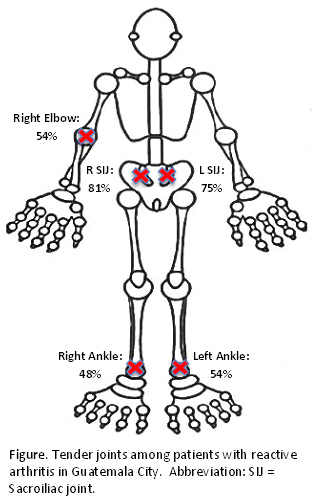Session Information
Date: Sunday, November 8, 2015
Session Type: ACR Poster Session A
Session Time: 9:00AM-11:00AM
Background/Purpose: Reactive
arthritis (ReA) is an inflammatory arthritis that typically follows infection. The
objectives of this study were to describe the joint and enthesial involvement
among patients with ReA in Guatemala City and to examine the prevalence of SI
joint disease on Xrays and Achilles enthesopathy on ultrasound in patients with
ReA and controls.
Methods: We performed a
prospective cross-sectional study between January and October 2014 in Guatemala
City. ReA was defined as inflammatory arthritis following a gastrointestinal (GI)
or genitourinary infection (GU) and meeting the ASAS peripheral spondyloarthropathy
criteria. Cases were identified in AGAR Rheumatology clinic and controls with a
GI or GU infection in the preceding 3-6 months were recruited from primary care
clinics in the same institution. A standardized questionnaire ascertained
infection details, family history, medication and herbal supplement use,
medical comorbidities, employment, place of residence (urban vs rural), smoking
status, and literacy. Subjects completed the mini-nutritional assessment, a
pain assessment, a standardized joint and enthesis examination by same observer,
radiographs of the sacroiliac (SI) joints interpreted by a trained radiologist
and 2 blinded rheumatologists, and ultrasound of the bilateral Achilles Tendons.
Results: 33 patients with ReA
and 31 controls were enrolled. Mean age was 39 (SD 11.3) and 36 (SD 10.1)
respectively. None of the controls had swollen or tender joints or entheses. We
found that 32 cases (97%) had a recent history of peripheral arthritis. History
of uveitis was present in 20 cases (60%). The most frequently tender joint was
the right sacroiliac joint (N=27, 81%) followed by left sacroiliac joint (N=25,
75%). The most frequently swollen joint was the left ankle (N=4, 12%) followed
by right ankle (N=3, 9%). The most frequently tender enthesis was the Achilles
tendon, right and left (N=22 each, 67%) followed by right medial femoral
condyle (N=17, 52%). The most common finding on sacroiliac joint Xray was bilateral
sacroiliitis (N=15, 45%). Bilateral SI joint abnormalities were also found in 10
controls (32%). Inflammation was noted on Achilles tendon ultrasound in 13 (39%)
cases and in one (3 %) of the controls.
Conclusion: Reactive
Arthritis is the most common form of the Spondyloarthropathies in Guatemala
City. To our knowledge, this is the first study in the Central American region
to examine clinical and imaging features of ReA. A strength of the study was
inclusion of a control group exposed to infection. We found a high prevalence
of peripheral arthritis, tender SI joints, and uveitis. Additionally, Achilles
tendon ultrasound was positive in nearly 40% of patients (compared to 3% of
controls). Interestingly, SI joint xrays were frequently abnormal in both
cases and controls (45% vs 32%).
To cite this abstract in AMA style:
Garcia Ferrer HR, Garcia Kutzbach A, Iraheta I, Scher JU, Von Feldt J, Ogdie-Beatty A. Clinical and Imaging Features of Reactive Arthritis in Guatemala City [abstract]. Arthritis Rheumatol. 2015; 67 (suppl 10). https://acrabstracts.org/abstract/clinical-and-imaging-features-of-reactive-arthritis-in-guatemala-city/. Accessed .« Back to 2015 ACR/ARHP Annual Meeting
ACR Meeting Abstracts - https://acrabstracts.org/abstract/clinical-and-imaging-features-of-reactive-arthritis-in-guatemala-city/

